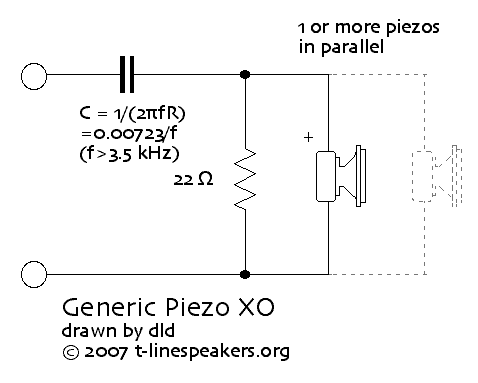|
Piezo tweeter crossovers?
(a page with operation principals & more on cross-overs)
Piezo tweeters get a bad rap.
The reason why is that they are most often used in such a way that the inherent capacitive
reactance is used to roll them off at the bottom. Used this way they get fairly ugly
sounding in their lower ranges & will often make the amplifier unstable making
everything sound bad. A piezo looks to the amp like a capacitor with very high impedance
magnitude at low frequencies & approaches zero at high frequencies.
Crossed over properly a pieze can give quite respectable performance (ie the $3.5k
Phy-HP KM-30
uses a piezo)
(cut
and paste, most of the below information credited to JON RISCH)
The Parts Express catalog suggests putting a 20-Ohm resister inline with any Piezo
tweeter to make it a more stable load for an amp.Will this not also attenuate the
tweeter? If so, and if I need further attenuation, can I simply add more resistance?
Is there a rule of thumb for how much attenuation I will get with further resistance,
or a way to compute this number?
The recommended resistor is to help protect the amplifier from oscillating due to
the raw capacitance that is a piezo driver. Adding resistance in series with a piezo
will actually roll off the highs a bit, adding more will roll off the highs noticably.
To attenuate a piezo, add a series cap, which creates a voltage divider with the
capacitance that is the piezo drive element. Most piezo elements run in the 0.1 to
0.26 uF range, so a cap of the same value as the piezo element will attenuate it
6 dB.
Piezo's can be crossed over, and to great advantage. I have often thought that some
of the bad rap piezo drivers have is due to the "you can use them without a
crossover" fallacy. Yes, you _can_ use them without a crossover, but just because
you can get away with it, does not mean it is optimal.
Since most piezo's are used in inexpensive systems, the cost of adding in "unecessary"
components is often never even considered.
How to crossover a piezo:
Add a resistor in parallel, and the driver can be made to look like a current driven
device to any outside components, such as a crossover cap. However, to keep costs
and power dissipation down, 8 ohms is way too small of a value. The impedance of
most piezo's is still quite high at 20KHz, so use a 22 ohm resistor, this makes any
series crossover cap smaller and less expensive, and the resistor dissipates less
energy. Use of an 8 ohm parallel resistor will also tend to lose you a little bit
of output level.
For most piezos, use of a 22 ohm resistor, and a 4-4.7 uF cap will allow the response
to be identical to what it was in stock form, but rolls off the lows at 6 dB/oct
below 1 kHz or so. This actually increases the power handling of the piezo, as it
is voltage limited. Exceed the voltage used to pole (polarize the piezo element during
manufacture) the unit, and it will loose sensitivity, and eventually burn out. Most
pro grade piezos will handle 35 volt transients, and 28 volts continuous, which are
150 watts and 100 watts into 8 ohms respectively.
Add in a capacitor and 22 ohm resistor, and the power handling could effectively
be quadrupled, as the LF voltages are not imposed upon the unit, just the HF voltages.

Piezo's crossed over in this manner don't sound as harsh and spity, and tend to be
quite a bit more reliable. Many of the piezo units have a mild peak just before they
roll off in the LF, so making the series cap a little smaller can actualy flatten
response, and provide even more protection and smoother sound. For the smaller piezo
units that cut off at 4-5 kHz, a series cap of 1.5 uF will do the trick, larger units
that go down to 3 kHz can use a 2.2 uF, and the large compression driver units meant
to be mounted on a horn need about 5 uF, as they do not peak, and any higher would
lose the sloping output even more.
Attenuation, HF roll-off AND the crossing over can all be done at the same time.
To attenuate, place a cap in between the piezo and the 22 ohm resistor that is shunting
across the unit, then if HF roll-off is desired, use a series resistor in this location
too. Then the series crossover cap should be in front of the 22 ohm shunt.
Looking from the amp, first the series crossover cap, say 4 uF, then the 22 ohm shunt
from hot to ground, then a series cap of about 0.15 uF for 6 dB attenuation, and
then a series resistor of about 30-50 ohms to tame the very top end, then the piezo
itself.
|